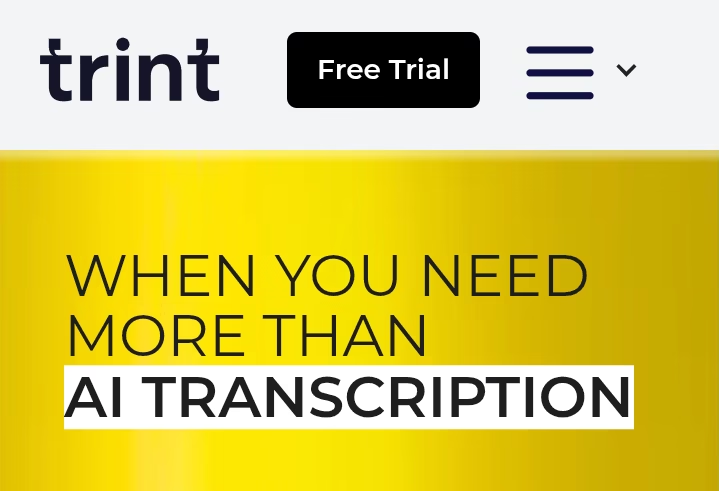What is Trint AI?
Trint is an AI-powered transcription and content editing tool that converts audio, video, and speech into text. It supports more than 40 languages, offers live transcription, and includes features like subtitle creation, translation, and collaborative editing. It’s built for storytellers, content creators, journalists, businesses, and educators who need reliable, fast, and secure transcription workflows.
Key Features
Here are some of the standout features that make Trint AI powerful:
Multi-Language Transcription: Trint can transcribe audio/video in 40+ languages with claimed accuracy up to ~99% in ideal conditions.
Live Transcription / On-the-Go Capture: You can record speech or audio (even via mobile) and transcribe live. Useful for interviews, meetings, lectures. Editing Interface with Media Sync: The transcript editor is linked with audio/video playback, allowing you to edit while listening, fix mistakes, adjust speaker tags, etc.
Summaries & Searchability: Long transcripts can be summarized via AI, and you can search for keywords/timestamps to find moments easily.
Subtitles & Translation: Create subtitles (closed captions) and translate transcripts into many languages to broaden reach and accessibility.
Collaboration Tools & Workflow Integrations: Real-time collaboration, shared drives, role permissions; also integrates with cloud storage, APIs, etc.
Security & Data Privacy: Trint is ISO 27001 certified; users’ uploaded content stays theirs, with secure handling and optional data storage in US or EU; AI training does not use user transcripts.
Benefits
Using Trint AI can deliver many benefits:
Huge time savings: Manual transcription is slow and error-prone; Trint automates much of it, letting users focus on editing rather than typing.
Better content reuse: Transcript + editor + search = you can repurpose interviews, podcasts, video soundbites for blog posts, social media, captions etc.
Accessibility & global reach: Subtitles and translations help non-native audiences, hearing-impaired users, or cross-language content.
Enhanced collaboration: Team members can work together on transcripts, highlight, comment, assign tasks inside Trint.
Improved workflow consistency: With integrations and APIs, Trint fits into existing workflows (e.g., content production, journalism, education), reducing friction.
Limitations & Considerations
Trint is powerful, but there are some things to watch out for:
Accuracy depends on audio quality: Background noise, overlapping speech, strong accents can degrade accuracy, meaning more manual corrections.
Cost for heavy or large-scale usage: Premium plans or enterprise tiers are more expensive; for individuals who need many hours, the cost may add up.
Speaker identification and language nuance: Especially in multi-speaker situations or in less common dialects, distinguishing speakers or capturing nuance might be imperfect.
Limitations of summary tools: AI summaries are helpful but not always perfect; they may miss subtle details or context. They also usually require minimum transcript length.
Use Cases
Trint AI is used across many fields:
Journalism & Media: Transcribing interviews, speed-editing, quoting sources, generating subtitles.
Podcasters & Content Creators: Turning audio into blog posts, clipping key segments, improving reach via translated captions.
Education & Research: Lectures, seminars, qualitative research transcriptions, analysis.
Legal & Business: Meetings, depositions, compliance, internal communication documentation.
Marketing Teams: Social media content, repurposing video content, subtitles for marketing videos.
How to Use Trint Effectively (Tips)
Here are some tips to get the most out of Trint:
Ensure good audio: Use clear recordings, reduce background noise, minimize overlapping voices.
Use the custom dictionary: Add specialized terms, names, or jargon so transcription matches your domain.
Leverage timestamps & keyword search: Makes finding important parts fast.
Use collaboration features: Let multiple users work together to edit and finalize transcripts.
Translate and use subtitles to broaden audience reach.
Security & Privacy
Trint’s strong points in privacy:
ISO 27001 certification ensures organizational security standards.
Users retain ownership of their data; Trint does not use user-uploaded content to train its core AI models.
Data storage options (US/EU) help with regulatory compliance.
Final Thought
If you deal with audio or video content—be it interviews, podcasts, meetings, or lectures—Trint AI is a go-to tool for transcribing, editing, translating, and collaborating. It blends speed, reasonable accuracy, and useful features, making your content workflows faster and more efficient.
It’s not perfect, especially in tough audio or multi-speaker contexts, but for most use cases it delivers exceptional value.

Leave a Reply